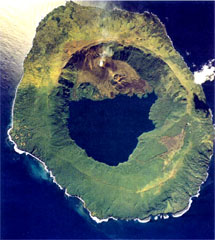Report on Tofua (Tonga) — July 2013
Bulletin of the Global Volcanism Network, vol. 38, no. 7 (July 2013)
Managing Editor: Richard Wunderman.
Tofua (Tonga) 2005 field observations and elevated temperatures detected during 2011-2013
Please cite this report as:
Global Volcanism Program, 2013. Report on Tofua (Tonga) (Wunderman, R., ed.). Bulletin of the Global Volcanism Network, 38:7. Smithsonian Institution. https://doi.org/10.5479/si.GVP.BGVN201307-243060
Tofua
Tonga
19.75°S, 175.07°W; summit elev. 515 m
All times are local (unless otherwise noted)
Tofua is a remote volcano in Tonga that is not monitored. The active Lofia crater, the largest and northernmost cone, appears to be undergoing a long-term, low level eruption, with spatter from a small vent containing lava, thin gaseous emissions, and an infrequent plume (BGVN 36:07 and 36:09). This report covers activity since our previous reports in July and September 2011, enumerates thermal alerts since April 2009, and quotes part of a blog published in 2005 by a traveler to Tofua that was not previously included in our previous reports.
During 13-14 August 2012, the Wellington Volcanic Ash Advisory Centre (VAAC) issued several volcano ash advisories, based on a pilot report and subsequently confirmed by the Tongan Meterological Service. Apparently, however, the advisories were triggered by a scrub fire that residents had set to flush out wild boars.
A previous report (BGVN 34:02) listed thermal alerts through 6 April 2009. Since then, ten thermal alerts were recorded through 27 September 2013, listed in table 2.
Table 2. Thermal alerts between 4 March 2011 and 27 September 2013. Thermal alerts are derived from data collected by the MODIS thermal sensors aboard the Aqua and Terra satellites and processed by the Hawaii Institute of Geophysics and Planetology using the MODVOLC algorithm. Courtesy of Hawaii Institute of Geophysics and Planetology.
| Date (UTC) | No. of Pixels | Satellite |
| 04 Mar 2011 | 1 | Aqua |
| 04 Nov 2011 | 1 | Aqua |
| 06 Mar 2012 | 1 | Aqua |
| 09 Mar 2012 | 1 | Terra |
| 22 Mar 2012 | 1 | Aqua |
| 01 Sep 2012 | 1 | Terra |
| 20 Jan 2013 | 1 | Aqua |
| 23 Jan 2013 | 1 | Terra |
| 25 Aug 2013 | 1 | Aqua |
| 15 Sep 2013 | 1 | Terra |
The following is a portion of a blog published by Richard Cowley on the STA Travel Blogs website on 9 August 2005. The author and fourteen others traveled to Tofua by boat and hiked to the summit. In the author's words:
"We took about 2 hours to reach the summit of the island through a mixed terrain of jungle. When we got to the summit we set up camp again on a volcanic type surface which was really strange and nothing like I had seen before. Once we had set up camp we headed towards the active volcano walking around the rim of the island gaining some great views at the same time. The whole island had a great big lake in the middle of it with the old craters of extinct volcanoes and then the big one which was still active. We headed around the rim and down towards the active volcano. Once we got up to the active volcano which was a steep climb we could look right into the creator [sic] where we could see all of the lava below and smell all the gases coming out of the crater ...".
Geological Summary. The low, forested Tofua Island in the central part of the Tonga Islands group is the emergent summit of a large stratovolcano that was seen in eruption by Captain Cook in 1774. The summit contains a 5-km-wide caldera whose walls drop steeply about 500 m. Three post-caldera cones were constructed at the northern end of a cold fresh-water caldera lake, whose surface lies only 30 m above sea level. The easternmost cone has three craters and produced young basaltic-andesite lava flows, some of which traveled into the caldera lake. The largest and northernmost of the cones, Lofia, has a steep-sided crater that is 70 m wide and 120 m deep and has been the source of historical eruptions, first reported in the 18th century. The fumarolically active crater of Lofia has a flat floor formed by a ponded lava flow.
Information Contacts: Wellington Volcanic Ash Advisory Centre (VAAC), Meteorological Service of New Zealand Ltd (MetService), PO Box 722, Wellington, New Zealand (URL: http://www.metservice.com/vaac/ , http://vaac.metservice.com/); Hawai'i Institute of Geophysics and Planetology (HIGP), MODVOLC Thermal Alerts System, School of Ocean and Earth Science and Technology (SOEST), Univ. of Hawai'i, 2525 Correa Road, Honolulu, HI 96822, USA (URL: http://modis.higp.hawaii.edu/); Earthquake Report (URL: http://earthquake report.com/); and STA Travel Blog (URL: http://blogs.statravel.com).

